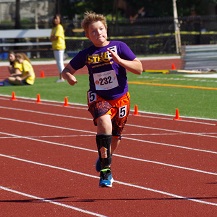
Let’s get moving! Many kids, teens and adults with hemiplegia or hemiparesis enjoy leisure and competitive sports. Below you’ll find tips for locating sports opportunities in your community.
- Begin by playing sports for fun in your backyard. Catch and throw Nerf balls. Get a basketball hoop. You can start small and upgrade as they grow.
- Try lots of different sports. You may not know which sport you child enjoys most and which they will be best at for many years, so try everything.
- Look for “learn to play” leagues through your parks and recreation or YMCA.
- We do not suggest organized sports teams prior to age 5. And some kids may not be ready even by age 5. Every child is different. Do not push. If they cry before, during or after, they are not ready.
- T-ball and soccer are good first sports. Rec leagues are usually not competitive, so this is a good place to begin.
- Be your child’s team coach if at all possible.
- If they struggle to keep up with stronger or faster athletes, request that they be allowed to play one year below their age. If you get opposition, do not give up. Explain why you are asking: so your child can keep up, not dominate the league.
- Extra training is not necessary at this level. We believe playing is the best training.
- Once your child reaches junior high age (7th grade), allow them to try out for school teams. You may see their sports interests narrowing at this age. School teams are very competitive. Know that even the strongest athletes can and do get cut from their school teams. It is part of life.
- Inform your child’s coach about his or her strengths and weaknesses. Offer suggestions. Ie: my child is strongest on his left side, so he is best playing on the left side of the soccer field.
- Extra lessons at the junior high level or high school level are okay in moderation.
- Great sports for one handed play: Tennis, Table Tennis, Bowling, Golf, Disc Golf
- Don’t limit yourself. Try everything they are interested in until you find something they enjoy.

Learn more about Sports for Individuals with Hemiplegia
Article written by Patti Scrivano. Patti’s son, Danny, had a stroke at age two that left him completely paralyzed in his right arm and hand and weak in his right leg and foot. He wears a hinged AFO (ankle foot orthosis). Danny began playing sports as soon as he began walking again after his stroke. Danny is a recipient of a CHASA Athletic Scholarship. Meet Danny.






